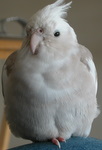What is a normal amount of Periodic Breathing?
- SleepingUgly
- Posts: 4690
- Joined: Sat Nov 28, 2009 9:32 pm
What is a normal amount of Periodic Breathing?
My System One Auto reports Periodic Breathing in percentages. What is a "normal" amount of Periodic Breathing in percents vs. significant PB that is noteworthy?
_________________
| Mask: Swift™ FX For Her Nasal Pillow CPAP Mask with Headgear |
| Humidifier: S9™ Series H5i™ Heated Humidifier with Climate Control |
| Additional Comments: Rescan 3.10 |
Never put your fate entirely in the hands of someone who cares less about it than you do. --Sleeping Ugly
Re: What is a normal amount of Periodic Breathing?
Good question! I've wondered that, myself.
Thanks for asking the question I was thinking about!
Thanks for asking the question I was thinking about!
_________________
| Mask: TAP PAP Nasal Pillow CPAP Mask with Improved Stability Mouthpiece |
| Additional Comments: Sleepyhead software, not listed. Currently using Dreamstation ASV, not listed |
-- Kiralynx
Beastie, 2008-10-28. NEW Beastie, PRS1 960, 2014-05-14. NEWER Beastie, Dream Station ASV, 2017-10-17. PadaCheek Hosecover. Homemade Brandy Keg Chin Support. TapPap Mask.
Min PS = 4, Max PS = 8
Epap Range = 6 - 7.5
Beastie, 2008-10-28. NEW Beastie, PRS1 960, 2014-05-14. NEWER Beastie, Dream Station ASV, 2017-10-17. PadaCheek Hosecover. Homemade Brandy Keg Chin Support. TapPap Mask.
Min PS = 4, Max PS = 8
Epap Range = 6 - 7.5
Re: What is a normal amount of Periodic Breathing?
Google is your friend:SleepingUgly wrote:My System One Auto reports Periodic Breathing in percentages. What is a "normal" amount of Periodic Breathing in percents vs. significant PB that is noteworthy?
It looks like the BiPAP increases the pressure during these events to reduce them."Periodic breathing is defined as alternating periods of hyperventilation with waxing/waning tidal volume and periods of central hypopneas or apneas. There are many forms of periodic breathing, one of which is Cheyne-Stokes Respiration (CSR) CSR is characterized by a cyclic pattern of waxing and waning during periods of apnea, and deep rapid breathing."
See here: http://bipapautosv.respironics.com/
_________________
| Mask: Swift™ FX Nasal Pillow CPAP Mask with Headgear |
| Additional Comments: Pressure 11.5 cm, Cflex off, Humidity off, or 1 to 2 |
- SleepingUgly
- Posts: 4690
- Joined: Sat Nov 28, 2009 9:32 pm
Re: What is a normal amount of Periodic Breathing?
Yes, but my question was what percentage is a "normal" amount of PB on a nightly basis. Just like a certain amount of central apneas are "normal", I assume some amount of periodic breathing is "normal" and not clinically significant.Tielman wrote:Google is your friend:
"Periodic breathing is defined as alternating periods of hyperventilation with waxing/waning tidal volume and periods of central hypopneas or apneas. There are many forms of periodic breathing, one of which is Cheyne-Stokes Respiration (CSR) CSR is characterized by a cyclic pattern of waxing and waning during periods of apnea, and deep rapid breathing."
_________________
| Mask: Swift™ FX For Her Nasal Pillow CPAP Mask with Headgear |
| Humidifier: S9™ Series H5i™ Heated Humidifier with Climate Control |
| Additional Comments: Rescan 3.10 |
Never put your fate entirely in the hands of someone who cares less about it than you do. --Sleeping Ugly
Re: What is a normal amount of Periodic Breathing?
Unfortunately, neither the definition of periodic breathing, nor the Respironics page actually answers the question asked.
If we have an AHI below 5, that's considered a normal apnea-hypopnea index.
The question is, not what is periodic breathing, but what per cent or below of PB is normal?
If we have an AHI below 5, that's considered a normal apnea-hypopnea index.
The question is, not what is periodic breathing, but what per cent or below of PB is normal?
_________________
| Mask: TAP PAP Nasal Pillow CPAP Mask with Improved Stability Mouthpiece |
| Additional Comments: Sleepyhead software, not listed. Currently using Dreamstation ASV, not listed |
-- Kiralynx
Beastie, 2008-10-28. NEW Beastie, PRS1 960, 2014-05-14. NEWER Beastie, Dream Station ASV, 2017-10-17. PadaCheek Hosecover. Homemade Brandy Keg Chin Support. TapPap Mask.
Min PS = 4, Max PS = 8
Epap Range = 6 - 7.5
Beastie, 2008-10-28. NEW Beastie, PRS1 960, 2014-05-14. NEWER Beastie, Dream Station ASV, 2017-10-17. PadaCheek Hosecover. Homemade Brandy Keg Chin Support. TapPap Mask.
Min PS = 4, Max PS = 8
Epap Range = 6 - 7.5
Re: What is a normal amount of Periodic Breathing?
I'm going out on a limb, but it probably depends on the person. I doubt there is a number that (like the <5 AHI discussed) would be general for everyone.SleepingUgly wrote:Yes, but my question was what percentage is a "normal" amount of PB on a nightly basis. Just like a certain amount of central apneas are "normal", I assume some amount of periodic breathing is "normal" and not clinically significant.
Do we know how many "central" apneas a night is ok?
_________________
| Mask: Swift™ FX Nasal Pillow CPAP Mask with Headgear |
| Additional Comments: Pressure 11.5 cm, Cflex off, Humidity off, or 1 to 2 |
- JohnBFisher
- Posts: 3821
- Joined: Wed Oct 14, 2009 6:33 am
Re: What is a normal amount of Periodic Breathing?
SleepingUgly, remember of course this is not a medical opinion, just information from my reading. However, what I've seen is that Periodic Breathing is often associated with cardiac problems. Not always. Essentially it indicates the body overshoots and then undershoots the respiration rate. You first breathe too quickly then as the O2 levels increase and CO2 decreases the body overshoots and does not feel the need to breathe. This can lead to periodic breathing. Though cardiac problems are often linked to periodic breathing, I think I saw an article that indicated that long term exposure to CO2 (essentially due to untreated OSA) for a long time can cause the body to do this.SleepingUgly wrote:My System One Auto reports Periodic Breathing in percentages. What is a "normal" amount of Periodic Breathing in percents vs. significant PB that is noteworthy?
So, what percentage is "normal". None. If you have a high number of central apneas and periodic breathing, do discuss it with your doctor. You might want to ask if the periodic breathing might be indicative of other problems.
Again, from my reading it appears that some people just experience periodic breathing when most of us don't. But they are otherwise healthy. So, don't be alarmed if you see some percentage. A low amount is probably not an issue. But you should definitely check with your doctor about it. Always better to check early than to wait until more obvious symptoms appear.
It's part of the AHI number. So, any apnea (central or obstructive) plus hypopnea should be kept less than 5 per hour.Tielman wrote:Do we know how many "central" apneas a night is ok?
Actually, that's an ASV unit, not a BiPAP unit. BiPAP does not address problems with either central apneas nor periodic breathing. Trust me, I know from experience on this all too well. Event with a BiPAP unit, I had severe apnea (AHI > 30). I had six times the number of central events as I did obstructive events. But with my ASV unit (ResMed VPAP Adapt SV), I now sleep without any apneas at all. Though I periodically experience Hypopneas, the AHI typically is much lower than 5 per hour.Tielman wrote:It looks like the BiPAP increases the pressure during these events to reduce them.
See here: http://bipapautosv.respironics.com/
Hope that helps.
_________________
| Mask: Quattro™ FX Full Face CPAP Mask with Headgear |
| Additional Comments: User of xPAP therapy for over 20 yrs. Resmed & Respironics ASV units with EEP=9cm-14cm H2O; PSmin=4cm H2O; PSmax=15cm H2O; Max=25cm H2O |
"I get up. I walk. I fall down. Meanwhile, I keep dancing” from Rabbi Hillel
"I wish to paint in such a manner as if I were photographing dreams." from Zdzisław Beksiński
"I wish to paint in such a manner as if I were photographing dreams." from Zdzisław Beksiński
Re: What is a normal amount of Periodic Breathing?
JohnJohnBFisher wrote:SleepingUgly, remember of course this is not a medical opinion, just information from my reading. However, what I've seen is that Periodic Breathing is often associated with cardiac problems. Not always. Essentially it indicates the body overshoots and then undershoots the respiration rate. You first breathe too quickly then as the O2 levels increase and CO2 decreases the body overshoots and does not feel the need to breathe. This can lead to periodic breathing. Though cardiac problems are often linked to periodic breathing, I think I saw an article that indicated that long term exposure to CO2 (essentially due to untreated OSA) for a long time can cause the body to do this.SleepingUgly wrote:My System One Auto reports Periodic Breathing in percentages. What is a "normal" amount of Periodic Breathing in percents vs. significant PB that is noteworthy?
So, what percentage is "normal". None. If you have a high number of central apneas and periodic breathing, do discuss it with your doctor. You might want to ask if the periodic breathing might be indicative of other problems.
Again, from my reading it appears that some people just experience periodic breathing when most of us don't. But they are otherwise healthy. So, don't be alarmed if you see some percentage. A low amount is probably not an issue. But you should definitely check with your doctor about it. Always better to check early than to wait until more obvious symptoms appear.
It's part of the AHI number. So, any apnea (central or obstructive) plus hypopnea should be kept less than 5 per hour.Tielman wrote:Do we know how many "central" apneas a night is ok?
<snip>
A very nicely worded & meaningful analysis.
Excellent post
Here John (I believe) is pointing out that the quote re 'Bipap' from Tielman, is mixing up a straight 'bipap' withwhat an AutosSV Bipap can do - two quite different machines with different capabilities.JohnBFisher wrote:Actually, that's an ASV unit, not a BiPAP unit. BiPAP does not address problems with either central apneas nor periodic breathing. Trust me, I know from experience on this all too well. Event with a BiPAP unit, I had severe apnea (AHI > 30). I had six times the number of central events as I did obstructive events. But with my ASV unit (ResMed VPAP Adapt SV), I now sleep without any apneas at all. Though I periodically experience Hypopneas, the AHI typically is much lower than 5 per hour.Tielman wrote:It looks like the BiPAP increases the pressure during these events to reduce them.
See here: http://bipapautosv.respironics.com/
Hope that helps.
DSM
xPAP and Quattro std mask (plus a pad-a-cheek anti-leak strap)
Re: What is a normal amount of Periodic Breathing?
I too have wondered about both the best definition of PB and the significance of PB scoring. On rare occasions it shows up on my BipapSV data & I gather the latest Respironics models include PB scoring for informational purposes.Kiralynx wrote:Unfortunately, neither the definition of periodic breathing, nor the Respironics page actually answers the question asked.
If we have an AHI below 5, that's considered a normal apnea-hypopnea index.
The question is, not what is periodic breathing, but what per cent or below of PB is normal?
The description provided by JohnBFisher is the simplest & easiest to understand description I have seen thus far & also fits in with what makes sense.
Perhaps some broader questions could include ...
1) Can anyone describe forms of PB outside the classic Cheynes-Stokes Respiration examples ? (http://en.wikipedia.org/wiki/Cheyne-Stokes_respiration).
(The only other defs I can ever find refer to infants exhibiting PB, Heart patients exhibiting PB & the the classic CSR examples)
2) How common are these other forms of PB among the SDB population ?
3) Just what is being scored when PB gets flagged. ?
(Best I can work out is that the sleeper may be hyperventilating then hypoventilating for whatever reason & the machine sees this & flags it. I gather that the algorithm seeing PB, in the Respironics (other than the ASV machines) deactivates its pressure adjusting processes during periods that PB is being detected.
As best as I can tell PB can be acceptable in small bursts (but I have no idea what % is acceptable). The only conclusion I can draw is the point already made, that if the associated night's AHI score is low then the PB may not be an issue.
One other observation though, is that anyone who has shown examples of lots of PB in the data here on cpaptalk be it from a std Respironics machine or a Bipap ASV, they will usually add that they had a bad night & that in itself implies strongly that PB is not a good thing to be exhibiting.
Another comment is that I think the PB is a reflection of poor blood CO2 regulation ? - any one got any info re this ?
DSM
#2 - some links
http://www.drhull.com/EncyMaster/B/brea ... iodic.html
http://www.medterms.com/script/main/art ... ekey=10902
http://www.faqs.org/abstracts/Health/Ap ... atien.html
From the above link
>>
Central apnea occurs often during episodes of periodic breathing. Periodic breathing occurs when breathing becomes irregular, with periods of rapid breathing alternating with a temporary cessation of breathing. Apnea is the technical term for a temporary cessation of breathing. It can be caused by an obstruction in the throat or by an abnormality in the brain areas that regulate breathing. In the latter case, it is called central apnea. Periodic breathing can occur in health people, but when it occurs in patients with heart failure, it can worsen their disease.
<<
Here is a patent application that seeks to patent 'RESPIRATORY STIMULATION FOR TREATING PERIODIC BREATHING'
http://www.faqs.org/patents/app/20090099621
A good description taken from the above patent application ...
>>
In aerobic metabolism, the body uses oxygen to produce energy and generates carbon dioxide as a metabolic by-product. The physiological purpose of respiration in this regard is to maintain the proper concentrations of oxygen and carbon dioxide in the blood and other body tissues. As blood flows through the lungs, oxygen from inspired air is absorbed into the blood, while carbon dioxide is removed and blown off during expiration. A principal way in which the rhythm of respiration is regulated is through the respiratory center in the brainstem (in the pons and upper medulla). The respiratory center has chemosensitive areas that respond mainly to the concentration of carbon dioxide in the blood. When blood carbon dioxide increases, the respiratory center sends neural signals to the muscles controlling inspiration and expiration to cause an increase in the depth and/or rate of respiration and vice-versa when blood carbon dioxide decreases.
In certain individuals, a dysfunction in the respiratory control mechanism described above produces a pathological condition known as periodic breathing. One type of periodic breathing, Cheyne-Stokes breathing, is characterized by alternating cycles of hyperventilation and hypoventilation. When hyperventilation occurs, the pulmonary blood becomes excessively depleted of carbon dioxide. After some period of time, the pulmonary blood reaches the respiratory control center in the brain and/or respiratory chemoreceptors in the vasculature to cause suppression of respiration. The resulting hypoventilation then causes carbon dioxide in the pulmonary blood to rise excessively. After a transit time to reach the respiratory control center in the brain, the excessive carbon dioxide in the blood causes hyperventilation that starts the cycle again. In normal individuals, the cycles of hyperventilation and hypoventilation as just described do not occur because the transit time for pulmonary blood to reach the brain is short and the carbon dioxide concentration in the tissues is maintained by the circulation in a manner that buffers increases in the carbon dioxide concentration of pulmonary blood. In certain situations, however, the respiratory control mechanism becomes impaired so that Cheyne-Stokes respiration occurs. In patients with heart failure, cardiac output is decreased below normal and blood flow is correspondingly slow, causing the transit time for pulmonary blood to reach the brain to increase. Cheyne-Stokes respiration frequently occurs in heart failure patients and has been shown to be associated with a poorer prognosis and increased mortality. Abnormally elevated chemoreflex sensitivity associated with increased sympathetic activity is another cause of Cheyne-Stokes respiration, and increased sympathetic activity commonly occurs in heart failure patients. Another cause of Cheyne-Stokes respiration is damage to the respiratory control center in the brain that impairs the feedback mechanism for controlling inspiration and respiration. Damage to the respiratory control center can also cause a related condition known as central sleep apnea in which breathing ceases for prolonged periods during sleep.
<<
xPAP and Quattro std mask (plus a pad-a-cheek anti-leak strap)
Re: What is a normal amount of Periodic Breathing?
This is from: Medicinenet.com
Definition of Periodic breathing
Periodic breathing: Clusters of breaths separated by intervals of apnea (no breathing) or near-apnea. As opposed to normal breathing which is usually regular.
Periodic breathing was originally thought to arise from serious neurologic or cardiovascular disease and therefore to carry a poor outlook. It is now known that periodic breathing tends to occur during sleep, it can occur in healthy persons, and the apnea in periodic breathing is usually central (without respiratory movements) rather than obstructive (caused by upper-airway blockage).
Periodic breathing during sleep occurs typically in patients with congestive heart failure.
Definition of Periodic breathing
Periodic breathing: Clusters of breaths separated by intervals of apnea (no breathing) or near-apnea. As opposed to normal breathing which is usually regular.
Periodic breathing was originally thought to arise from serious neurologic or cardiovascular disease and therefore to carry a poor outlook. It is now known that periodic breathing tends to occur during sleep, it can occur in healthy persons, and the apnea in periodic breathing is usually central (without respiratory movements) rather than obstructive (caused by upper-airway blockage).
Periodic breathing during sleep occurs typically in patients with congestive heart failure.
Re: What is a normal amount of Periodic Breathing?
It's worth pointing out that a BiPAP Auto SV is NOT the same as an ordinary BiPAP or BiPAP Auto. I believe a plain old BiPAP Auto just registers the PB, but ignores it as far as increasing pressures are concerned.Tielman wrote: It looks like the BiPAP increases the pressure during these events to reduce them.
See here: http://bipapautosv.respironics.com/
_________________
| Machine: DreamStation BiPAP® Auto Machine |
| Mask: Swift™ FX Nasal Pillow CPAP Mask with Headgear |
| Additional Comments: PR System DreamStation and Humidifier. Max IPAP = 9, Min EPAP=4, Rise time setting = 3, minPS = 3, maxPS=5 |
Re: What is a normal amount of Periodic Breathing?
As the many links others have provided give no real clue to what "normal" is, I'll offer my own seat of my pants reactions to PB in my own reports with this caveat: I am NOT a doctor, nurse, or other medical professional.SleepingUgly wrote:My System One Auto reports Periodic Breathing in percentages. What is a "normal" amount of Periodic Breathing in percents vs. significant PB that is noteworthy?
I occasionally see as much as 2-3% PB during a night that lasts between 4.5 and 7 hours. (I still do not sleep any longer than that.) I think I've seen one night in the last 18 months where it may have been as high as 4%. But on the vast majority of my nights, PB = 0.0%. Hence, I've chosen not to worry about something that seems to occur in very small amounts at random times. There may be some connection to whether I'm over tired or dealing with more than usual congestion, but I haven't crunched the numbers because I simply don't see PB on anything approaching a regular basis.
Now--if I had congestive heart failure, I'd be watching the PB like a hawk. And if I started seeing PB on the majority of nights, I'd be inclined to run it by my docs---particularly if the PB was say greater than 10% on many of those nights. And why am I picking that 10% level out of the blue? Probably it's the mathematician in me: Something that happens less than 5% of the time is usually a statistical outlier; something that happens as much as 10% of the time is much less likely to just be a statistical outlier. So my reasoning on where I'd draw the line on when to start worrying about PB has nothing to do with any medical articles I've read, but rather it relies on my mathematician's common sense of when something may be occurring frequently enough to be an issue.
And then there's one more factor in how I'd make a decision on when to worry about PB given that there seem to be no official guidelines: Most of the time my trivial amounts of PB do NOT show the classic Cheyne-Stokes breathing pattern with a well defined CA in the middle of the low-volume part of the pattern. Hence my trivial amounts of PB are not contributing to an elevated CAI, and many of them are marginal examples of PB and may be mis-scored. But if I was seeing enough PB that looked like full blown C-S respiration and the number of CAs was enough to cause an elevated CAI, then I'd be talking to the docs. And by docs, I mean that I'd be talking to both a sleep doc and a cardiologist about whether the PB/CS stuff is a symptom of heart disease that needs to be investigated.
And just how much "Classic C-S breathing with CAs in the middle" would it take to cause my CAI to get close to 5.0? Well, on a typical 6 hour night, I'd need 30 CAs to cause a CAI = 5.0. And a C-S "cycle" is usually about 30 seconds to 2 minutes long. So let's assume the cycles are 30 second cycles (to minimize the total PB breathing time). So that means I'd need at least 15 minutes of well-established C-S breathing to lead to 30 CAs being scored. And 15 minutes is 4.16% of a 6 hour night. If the cycles lasted 1 minute each, we'd need 30 minutes of PB to get to where 30 CAs are scored. And 30 minutes is about 8.33% of the night. If the cycles lasted 2 minutes each, we'd need an hour of PB to get to where 30 CAs are scored. And one hour is 16.67% of a 6 hour night.
So the upshot of all this number crunching is that my heuristic 10% line for when I would start worrying about PB makes some mathematical sense to the mathematician in me. Whether it makes medical sense is something for someone with medical training to comment upon.
_________________
| Machine: DreamStation BiPAP® Auto Machine |
| Mask: Swift™ FX Nasal Pillow CPAP Mask with Headgear |
| Additional Comments: PR System DreamStation and Humidifier. Max IPAP = 9, Min EPAP=4, Rise time setting = 3, minPS = 3, maxPS=5 |
Re: What is a normal amount of Periodic Breathing?
When I looked at time periods flagged as PB by my PRS1 Auto, they didn't look like anything to be worried about. Yes, there was some degree of waxing and waning of flow rates, but the low flow rates were still in the range of what I'd call "normal" breathing. Nothing at all like CSR.
Yet another reason you need a fully data capable CPAP and software to look at it.
Yet another reason you need a fully data capable CPAP and software to look at it.
_________________
| Mask: Swift™ FX Nasal Pillow CPAP Mask with Headgear |
| Humidifier: S9™ Series H5i™ Heated Humidifier with Climate Control |
| Additional Comments: Also SleepyHead, PRS1 Auto, Respironics Auto M series, Legacy Auto, and Legacy Plus |
Please enter your equipment in your profile so we can help you.
Click here for information on the most common alternative to CPAP.
If it's midnight and a DME tells you it's dark outside, go and check for yourself.
Useful Links.
Click here for information on the most common alternative to CPAP.
If it's midnight and a DME tells you it's dark outside, go and check for yourself.
Useful Links.
- Zzzzzzzzzzz...
- Posts: 331
- Joined: Sun Mar 04, 2012 9:19 am
Re: What is a normal amount of Periodic Breathing?
I've got ataxic breathing/CSA. PB and centrals are all still so puzzling to me. I too, on occasion will see percentages of PB's on my ASV machine after sleep. The conundrum is that I could say the same for when I'm awake. I REALLY feel my breath rate/flow/pattern is similar in my wake state as in my sleep state. I'm conscious of the fact that I won't take a breath for what seems like a minute OFTEN during the day, it's NORMAL for me... and find myself waxing and waning while AWAKE to catch up... how can anyone explain that? And when I check my pulse/Co2 level it's always normal regardless. I can run most mornings for 40-50 minutes with no shortness of breath or any indication of CHF, etc. Puzzling... that being said, I'm still having an echocardiogram done this week to rule out any unforeseen heart issues I may have... I suppose stranger things have happened, but I'd be surprised if things didn't check out normal. As would my sleep doc who simply told me last week that there's still SO much they don't understand about sleep, and often patients exhibit idiopathic forms of CSA, CA and PB. Scratching head...
Great thread, (no rhyme intended)
Z
Great thread, (no rhyme intended)
Z
- SleepingUgly
- Posts: 4690
- Joined: Sat Nov 28, 2009 9:32 pm
Re: What is a normal amount of Periodic Breathing?
Wow, I started this thread a long time ago. Pretty depressing to see how little progress I've made. Well, at least I don't care about PBs anymore, so I guess there's that (current machine doesn't record them, and maybe that's just as well).
_________________
| Mask: Swift™ FX For Her Nasal Pillow CPAP Mask with Headgear |
| Humidifier: S9™ Series H5i™ Heated Humidifier with Climate Control |
| Additional Comments: Rescan 3.10 |
Never put your fate entirely in the hands of someone who cares less about it than you do. --Sleeping Ugly















